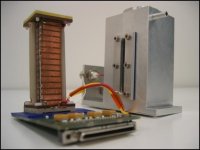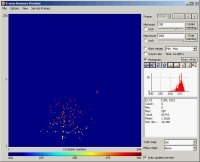 |
 |
|||||||||||||
|
|||||||||||||
|
|||||||||||||
|
Digitisation - a key word that could lead to smaller and simpler detectors. Two weeks ago, at Saclay, France, the CEA Time Projection Chamber group of Paul Colas proved it could build a digital TPC for the ILC. A truly collaborative effort, this breakthrough could significantly reduce the cost and simplify the implementation of this sub-detector. The CEA group's major activity is R&D on Micromegas (MICRO-MEsh GASeous detector) TPCs within the LC-TPC international collaboration. Their goal: achieve the construction of a reliable tracker prototype with 200 space points with a spatial resolution of less than 100 micrometres or even better. Parallel to the standard Micromegas studies, the group is developing a new readout technique with NIKHEF (Netherlands) and CERN. While crossing a TPC, tracks ionise a gas. Then the electrons drift towards the cathode and are amplified by different technologies, one of which is Micromegas, a fine micromesh structure and anode pads readout (find out more) To achieve their resolution aim, the TPC experts reduced the size of the sensors, called "pads". The problem is that each individual pad has to be electronically equipped, and sensors become quite busy with all the wires and connectors coming in and going out. The novel approach of a digital TPC is to use CMOS sensors combined with a gas amplifier grid. Each pixel is a 'one-stop shop' for the various functions of signal processing: preamplifier, shaper, discriminator, counter and so on, which reduces the cost and simplifies the treatment of the silicon detectors. The three teams from CEA, CERN and NIKHEF proposed to improve the already existing layout of a medical imaging chip called "Medipix" to make it applicable for particle physics trackers. It was only possible to advance this R&D in 2006, when they received funding through the European EUDET programme. When David Attié, a CEA-EUDET post-doc at Saclay, entered Paul Colas' team in 2006, his goal was to prove that they can implement a new generation of chip at CEA. He participated in the successful and encouraging tests on the new chip called "Timepix" that were conducted at CERN from November 2006 to September 2007. The Medipix chip is a fully equipped CMOS sensor that allows quick and precise measurements of the position coordinates of particle tracks on a given plane. Well adapted for the medical applications, unfortunately the track's Z-coordinate was missing, which made it difficult to use for particle physics experiments. This information can be deduced by measuring the time the signal starts in the chip. That is why the new chip, adapted for TPCs, "Timepix", integrated sophisticated internal clocks with a tuneable sampling frequency from 10 to 100 MHz. “Medipix is an industrial consortium and their chip layout is not public. We had to enter their collaboration to find ways to improve it, which at the end benefited both particle physics and medical research communities,” said Attié. The Timepix chip is 1.4 x 1.6 cm2 wide, with each pixel measuring 55 x 55 μm2, which means it can reach the ultimate spatial resolution a gas detector can give, as every single ionisation electron is detected -well beyond the initial goal of 200 points with a 100-micron resolution. During its tests, one of the biggest problems was that the amplification between anode and cathode around 80 kV/cm could generate sparks that killed the chips. At CEA, Colas and Attié finally succeeded to suppress these sparks by adding a highly resistive layer on top of the pads, following a process developed by colleagues from NIKHEF, CERN and Neuchâtel. Their tests were made with a small 6-centimetre TPC exposed to X-rays. Each single electron was finally detected. NIKHEF had already proved that they could achieve such measurement with the Timepix chip. Now, it's CEA's turn. “Thanks to the collaborative effort of CEA, NIKHEF and CERN, we have now proved in all labs that we can work with a digital TPC,” said Colas. In parallel, other groups in the world are studying the digital readout on the other types of TPCs based on GEMs, or Gas Electron Multipliers. -- Perrine Royole-Degieux See also the talk of Jan Timmermans from NIKHEF at last week's ALCPG07 workshop. |
|||||||||||||
| © International Linear Collider |

